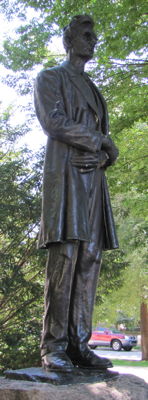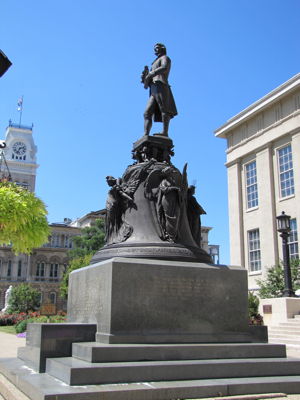
The following article by Charles Hartley originally appeared in The Courier-Journal on 11 Sep 2013. It is archived here with additional information for your reading enjoyment.

Visitors to Bernheim Forest today marvel at the natural beauty of its grounds, and the more adventurous revel in the rustic trails that meander through its forests. Yet while some know the name of its founder, few really know much about his life and his many generosities.
In 1928, when Isaac Bernheim began buying the land that would become Bernheim Forest, most of it was land that had been stripped of its trees and overworked as farm land, but he had a vision of returning this abused land to its natural state. His desire was to create a place that elevated the human spirit through the paths of art and nature. He envisioned "A sanctuary for birds…trees labeled carefully and protected…a natural park with a profusion of things that gladden the soul and please the sight…where the people of Kentucky and their friends may enjoy the values of forest and field." It would become his crowning achievement in a life filled with many accomplishments.
Isaac Wolfe Bernheim was born in November 1848 in Schmieheim, Germany to Leon and Fanny (Dreyfuss) Bernheim. His father died in 1856, and his mother married Louis Weil the next year.
Times were difficult, and the family moved to Freiburg where, at the age of 13, Isaac was apprenticed to a commercial house for three years. The first year was spent sweeping, dusting, and delivering packages. In his second year he was taught how to sell goods, and in the third year he learned the science of bookkeeping, correspondence, and handling money.
He later remembered that these experiences taught him to love work, practice economy, and be self-reliant.

He later went to work as a clerk for a firm in Frankfort that dealt in wholesale knit goods where he demonstrated his skill and determination to succeed.
In mid-summer of 1866, an uncle named Mr. Livingston, who lived in New York, was on a business trip to Germany and stopped over to visit the family. Learning that his nephew was working in Frankfort, he looked Isaac up. This meeting set Isaac to thinking about his future, and the possibilities open to an ambitious young man in America.
His uncle, who was engaged in the manufacture of cotton knitting yarn in New York, offered to pay his passage to America and give him a job, if he chose to come.
Although his mother and his employers urged him to remain where he was, Isaac decided to come to America.
When Isaac arrived in New York in March 1867, he learned that his uncle's business had declined severely due to the drop in prices for cotton yarn, and there were no jobs to be had. Mr. Livingston did give Isaac a place to stay in his own home.

Just when things seemed hopeless, a friend of his uncle who owned a store in Pennsylvania suggested that Isaac should try his hand at peddling "Yankee notions" in his part of Pennsylvania. His uncle bought the goods for Isaac on credit, guaranteeing the bill himself, and in May 1867 Isaac left New York to start his career as a peddler.
"Yankee notions" consisted of needles, pins, spool thread, socks, suspenders, handkerchiefs, and ladies' stockings; small things of little weight so that he could carry a large supply as he traveled from place to place.
This occupation afforded him the opportunity to familiarize himself with the language and customs of the people. He later recalled that it gave him a spirit of independence and self-reliance that stood him in good stead ever afterward.
His success led him to try to expand his business by purchasing a horse and wagon to haul even more goods. His success floundered when his horse died, and he was forced to sell his goods at auction.
Fortunately, another uncle, Benjamin Weille had moved his business to Paducah, Kentucky, and offered Isaac a clerking job there.
Not long afterward the firm of Bloom & Loeb, a wholesale liquor business, offered Isaac a job as their bookkeeper. Then in late 1869, the firm's traveling salesman left the firm, and Isaac applied for the job. It was agreed that he could have the job when the firm could find a replacement bookkeeper.
Isaac wrote to his brother Bernard, who was a clerk in Germany, about the opportunity, and in early 1870 Bernard arrived in Paducah to take the bookkeeping job, allowing Isaac to become the firm's salesman.
When an opportunity for the Bernheim brothers to become partners in the firm fell through, they looked for means to begin their own wholesale liquor business. Fortunately for them Elbridge Palmer, a local businessman, offered to become a silent partner in their business and extended them $2,000 to help get the business going.
At the beginning they confined their wholesale business to a radius of about 200 miles from Paducah. However, during the next fifteen years their trade expanded over the entire South and into parts of the West and Northwest.


By this time the Bernheim brothers had set their roots deep at Paducah. Isaac married Amanda Uri there in 1874, and their mother had arrived from Germany. However, the business had grown too large to remain in Paducah, so in 1888 they moved the firm to Louisville, which at the time was one of the great distributing centers for fine whiskies.
As the business continued to prosper, the company expanded, adding distilling operations to their ever-expanding wholesale distribution business. With the great success they were having, Isaac and Bernard wanted to give back to the community. They commissioned Moses Ezekiel, an accomplished sculptor, to do a statue of Thomas Jefferson which was donated to the city of Louisville and unveiled in November 1901. It stands today outside the Louisville Metro Hall.
Then in 1920 Isaac approached George Grey Barnard about producing a statue of Abraham Lincoln. Barnard did a third cast of one he had previously made for Cincinnati, Ohio and Manchester, England. It was placed outside the west end of the Louisville Free Public Library building, facing Fourth Street, and dedicated on October 22, 1922.



In 1929 he commissioned Charles H. Nichaus to produce two bronze statues, one of Henry Clay and the other of Ephraim McDowell. These were donated to the state of Kentucky, and placed in Washington, D.C. Henry Clay's statue may be seen today in the National Statuary Hall; McDowell's is in the Capitol Visitor's Center.
Other Bernheim donations included a wing on the Carnegie Free Public Library in Paducah, the first library of the Hebrew Union College in Cincinnati, and a complete water system for his birthplace, Schmieheim, Germany.
It was also in 1929 that Isaac Bernheim created the trust that would perpetually fund a significant portion of the upkeep of Bernheim Forest. The once-overworked farm and timberlands were slowly transformed over the next twenty years, and the forest was opened to the public in July 1950.
Isaac Wolfe Bernheim died in 1945, and did not live to see his forest open to the public. However, his and his wife's graves were moved from Cave Hill Cemetery to Bernheim Forest in 1956. They rest on a hillside overlooking the Great Meadow with a beautiful sculpture standing watch over them.

The next time you visit the forest, take time to stop by this beautiful gravesite, and thank him for his generosity and vision.
Copyright 2013 by Charles Hartley, Shepherdsville KY. All rights are reserved. No part of the content of this page may be included in any format in any place without the written permission of the copyright holder.
The Bullitt County History Museum, a service of the Bullitt County Genealogical Society, is located in the county courthouse at 300 South Buckman Street (Highway 61) in Shepherdsville, Kentucky. The museum, along with its research room, is open 10 a.m. to 4 p.m. Monday through Friday. Saturday appointments are available by calling 502-921-0161 during our regular weekday hours. Admission is free. The museum, as part of the Bullitt County Genealogical Society, is a 501(c)3 tax exempt organization and is classified as a 509(a)2 public charity. Contributions and bequests are deductible under section 2055, 2106, or 2522 of the Internal Revenue Code. Page last modified: 12 Sep 2024 . Page URL: bullittcountyhistory.org/memories/bernheim.html